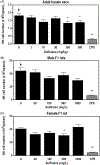Immunotoxicity studies of sulfolane following developmental exposure in Hsd:Sprague Dawley SD rats and adult exposure in B6C3F1/N mice
- PMID: 34357831
- PMCID: PMC8462997
- DOI: 10.1080/1547691X.2020.1869355
Immunotoxicity studies of sulfolane following developmental exposure in Hsd:Sprague Dawley SD rats and adult exposure in B6C3F1/N mice
Abstract
Sulfolane is a solvent used in the petrochemical industry and a groundwater contaminant in areas near refineries. The current studies were conducted to assess the impact of oral exposure to sulfolane on the immune system using two models: (1) a perinatal drinking water exposure to 0, 30, 100, 300, or 1000 mg/L from gestation day (GD) 6 until ∼13 weeks-of-age in Harlan Sprague Dawley rats; and, (2) a 90-day gavage exposure of adult female B6C3F1/N mice to 0, 1, 10, 30, 100, or 300 mg/kg/day. Immune parameters evaluated included measurement of antibody production against sheep red blood cells (SRBC) and keyhole limpet hemocyanin (KLH), ex vivo measurements of natural killer (NK) cell activity, cytotoxic T-cell (CTL) activity, and T-cell proliferation, as well as measures of splenic immune cell populations, hematological parameters, and histopathology of immune tissues. A decrease in ex vivo NK cell activity was observed in cells from female - but not male - F1 rats following developmental exposure. In adult female mice, splenic NK cell number was lower than the vehicle controls at doses ≥ 100 mg/kg; however, ex vivo NK cell activity was not affected by sulfolane treatment. In female mice, a decrease in the number of large unstained cells at doses ≥ 30 mg/kg was observed. In F1 rats, effects on white blood cells (WBC) were limited to a decreasing trend in leukocytes in females; no effects were observed in males. Under the conditions of this study, a no-observed-effect level (NOEL) of 3 mg/kg/day was identified based on reduced NK cell activity in female F1 rats. Overall, these findings suggest that oral exposure to sulfolane in rodents had minimal effects on the immune system.
Keywords: Immunotoxicity; NK cells; immune system; immunotoxicology; innate immunity; sulfolane.
Conflict of interest statement
Disclosure statement
The authors report no real or perceived conflicts of interest. The authors alone are responsible for the content of this manuscript.
Figures


References
-
- Alaska Department of Environmental Conservation (ADEC). 2012. Sulfolane concentrations in groundwater for select monitoring wells in North Pole Q2 10–55 ft below the water table. Juneau: ADEC. https://dec.alaska.gov/spar/csp/sites/north-pole-refinery/map/.
-
- ATSDR (Agency for Toxic Substances and Disease Registry) 2011. Health consultation – sulfolane. Available from: https://ntp.niehs.nih.gov/ntp/noms/support_docs/atsdrsulfolanehc_2011_50....
-
- Barnett JB. 1992. Comparison of the immunotoxicity of propanil and its metabolite, 3,4-dichloroaniline, in C57Bl/6 mice. Fundam Appl Toxicol. 18(4):628–631. - PubMed
-
- Bonneau R, Sheridan J, Feng N, Glaser R. 1991. Stress-induced suppression of herpes simplex virus (HSV)-specific cytotoxic T-lymphocyte and natural killer cell activity and enhancement of acute pathogenesis following local HSV infection. Brain Behav Immun. 5:170–192. - PubMed
Publication types
MeSH terms
Substances
Grants and funding
LinkOut - more resources
Full Text Sources
Miscellaneous
